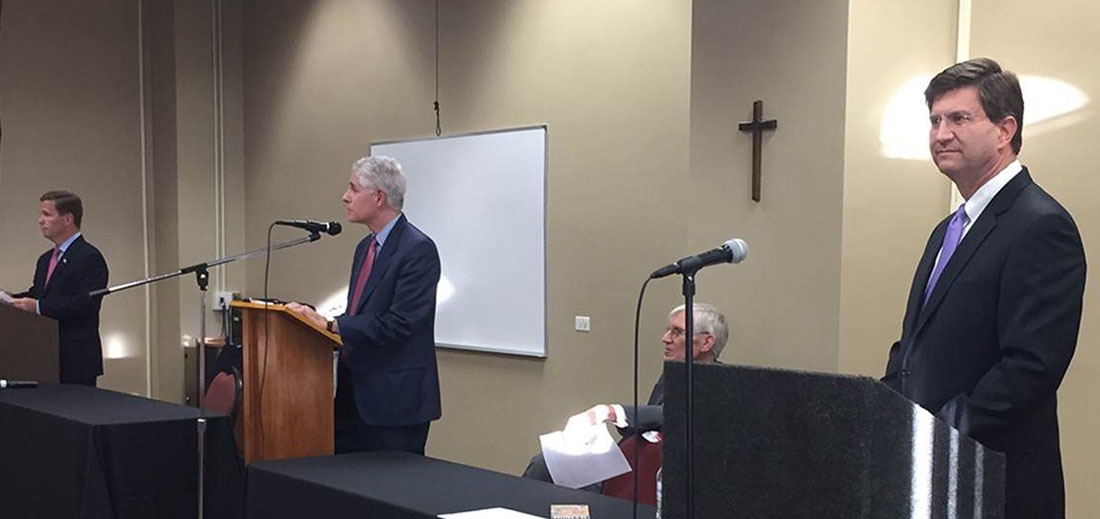By Sarah Haas and Nona Tepper
The stakes are high in Illinois’ 10th Congressional District.
That’s because incumbent Rep. Bob Dold and his Democratic challenger Brad Schneider are facing off once again, although their 2016 contest has proven to be different than their previous races in 2012 and 2014.
Both candidates have overhauled their political platforms in an effort to broaden their appeal. There also has been significant national focus on this local race to represent a district that includes the majority of Lake County and the northern tip of Cook County. Heading into Tuesday, the Election Projection political tracker predicts that Schneider is leading by 2.1 percent, though it is a “weak Democratic lead,” according to the site.
For months, political analysts and polls have deemed the race a “toss-up.” Political analyst Larry Sabato at the University of Virginia’s Center for Politics, as well as The Cook Political Report campaign analytics site both claim this race is too-close-to-call a clear forerunner.
Residents also appear ambivalent about who will win.
“It’s a very close race for both of them,” said Vicky Vargas, an 18-year-old student at Waukegan High School. “I think a lot of people are leaning towards Brad Schneider, but Dold is also very involved with all of his awards…he is seeping into the community.”
In the waning days of the campaign, both Dold and Schneider launched separate “Get Out The Vote” (GOTV) tours around the district.
Schneider held a series of GOTV phone banking sessions, and greeted voters at train stops and other events in conjunction with local Democratic Senate candidate Tammy Duckworth, and Susana Mendoza, a candidate for Illinois comptroller.
Riding around in a colorful campaign bus, Dold too launched his “People Before Politics” tour on Thursday, with stops to talk to voters across the district about the economy, job creation, healthcare and community safety. For the first time, Dold will be explaining to voters that he’s running on an “independent” platform ticket, which he defines as voting across parties on specific issues he believes in.
“There’s still too much partisan gridlock in Washington…which is why I’ve broken with my party when I think that they’re wrong and worked with other parties and when I think that they’re right,” Dold said in his opening remarks in a debate at Glenbrook South High School on Oct. 20. “Ultimately we’ve been ranked as one of the most independent bipartisan and effective member of Congress.”
Dold did not specify which organization ranked him as one of the most bipartisan Congressman, but the political rebrand comes at a time when Congress has been gridlocked over such issues as women’s reproductive rights.
Dold recently asserted his more moderate platform by breaking from the Republican party and voting against defunding Planned Parenthood in January 2016, a stark change from his vote to ban federal health coverage, which would include abortions, in 2011. Indeed, the 10th District is one of the few districts in the state that Planned Parenthood has refused to formally endorse either candidate since both Dold and Schneider are women’s health advocates, a Planned Parenthood spokesperson said.
Dold’s political flip on such topics as abortion, and his rebrand as an independent may be an attempt to showcase his ability to compromise, or perhaps an effort to distance himself from the Republican Party and its volatile presidential nominee, Donald Trump. His change has not gone unnoticed by 10th District residents.
“Congressman Dold is not an extremist Republican, like Donald Trump,” said Meryl Sosa, resident of Glenview, and executive director of the Illinois Psychiatric Institute. “He’s more of a moderate…And I think it’s a little bit different than other districts.”
Dold’s platform changeup is just one factor differentiating this election from years past.
Significant donations from national leadership political action committees (PACs) to both candidates also makes 2016 unique. Across the nation, PACs like the Democratic Congressional Campaign Committee, the National Republican Congressional Committee, the United States Chamber of Commerce and others have opened their pocketbooks to Dold and Schneider.
So far, Dold has raised more than $5 million to Schneider’s $3.9 million. Historically, a fundraising advantage has not necessarily equated to a win in the 10th District. In 2014, Dold trumped Schneider even though he raised less money. The opposite held in 2012, when Schneider beat Dold, despite the Democrat’s funding deficit.
The amount of national attention Schneider has received also is a change from previous years.
President Barack Obama and first lady Michelle Obama have lent their support to Schneider, with both releasing separate television advertisements for the Democrat. It is the first time either POTUS or FLOTUS has expressed an interest in this race.
“Brad is exactly the kind of leader we need in Congress,” Michelle Obama said in a widespread advertisement. “He’ll be a strong voice for Illinois.”
With a Gallup poll ranking Ms. Obama’s approval rating at a high of 65 percent, the endorsement could provide the boost that Schneider needs.
Still, by most accounts, the race remained too close to call right up until election day. And even though this ongoing battle between Dold and Schneider has the whiff of political deja-vu, residents say the candidates and the contest reflect the moderate tenor of the district.
“The two candidates are fairly close in a lot of ways because the district is that way,” said Sosa. “Because of this district they have to be both somewhat moderate and neither one can be extremists.”

